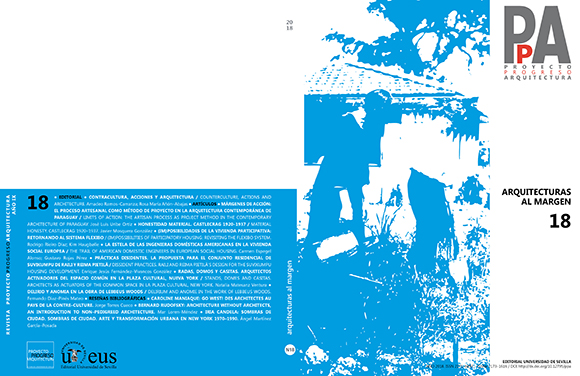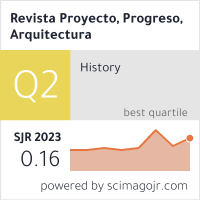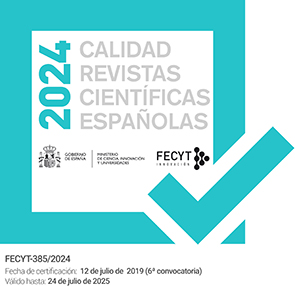(IM)POSIBILIDADES DE LA VIVIENDA PARTICIPATIVA: RETORNANDO AL SISTEMA FLEXIBO / (IM)POSSIBILITIES OF PARTICIPATORY HOUSING: REVISITING THE FLEXIBO SYSTEM
DOI :
https://doi.org/10.12795/ppa.2018.i18.03Mots-clés :
participación, Flexibo, Dinamarca, democracia vecinal, soportes y aportes, SCOT / participation, Denmark, tenant’s democracy, support infill, SCOTRésumé
RESUMEN El objetivo de este texto es analizar qué puede aprender la arquitectura contemporánea de las experiencias históricas de la arquitectura participativa. Partiendo de la teoría de la construcción social de la tecnología (SCOT), se estudia la tradición de vivienda participativa de los años sesenta y setenta. Se identifican los problemas a los que esta se enfrentó y cómo terminó resultando marginal. El artículo se centra en el caso ejemplar de Flexibo, un sistema de vivienda de soportes y aportes desarrollado en Dinamarca en los años setenta. Ciertas condiciones sociales e históricas en los países nórdicos establecieron un caldo de cultivo óptimo para la democratización de la vivienda, por lo que en estos países la influencia de la arquitectura participativa, si bien discreta, ha sido amplia. No obstante, el estudio revela la principal limitación de la arquitectura participativa tal como ésta sucedió: la mayor parte de los esfuerzos hacia la democratización de la vida cotidiana por parte de la arquitectura no fueron acompañado por la democratización de los procesos y las prácticas arquitectónicas. Ciertas experiencias coetáneas manifiestamente alternativas, se apuntan finalmente como pistas para aquellos interesados hoy en alcanzar el viejo objetivo de una participación transformadora.
SUMMARY The purpose of this paper is to discuss what contemporary architecture can learn from historical experience of participatory architecture. Based on the theory of social construction of technology (SCOT), this paper analyses the tradition of participatory architecture from the 1960s and 1970s. It identifies the problems faced by participatory architecture, and how participatory architecture turned out to be marginal to mainstream architecture. This paper focuses on the exemplary case of Flexibo, a housing system of support and infill developed in Denmark in the 1970s. Certain socio-historical conditions in the Nordic countries presented an optimal breeding ground for housing democracy, and in these countries the influence of participatory architecture, though modest, is still broad. Nevertheless, the study reveals the main limitation of this participatory architecture as it emerged: most of the efforts towards democratisation of everyday life by architecture came unaccompanied by parallel efforts towards democratisation of the everyday of architectural processes and practices. Finally, this paper points out some alternative ways to overcome the previous missteps for those today who are still interested in the old goal of a transforming participatory architecture.
Téléchargements
Références
AIBAR, Eduardo; BIJKER, Wiebe E. Constructing the city: The Cerdá Plan for the extension of Barcelona. Science, Technology and Human Values. Sage Pub., enero 1997, vol. 22, nº 1, pp. 3–30. ISSN 0162–2439. DOI: https://doi.org/10.1177/016224399702200101
ARNSTEIN, Sherry R. A ladder of citizen participation. Journal of the American Planning Association, American Planning Assoc., vol. 35, nº 4, pp. 216–24. ISSN 0194–4363. DOI: http://dx.doi.org/10.1080/01944366908977225
BLUNDELL JONES, Peter. Sixty–eight and after. En: BLUNDELL JONES, Peter; PETRESCU, Doina; TILL, Jeremy, eds. Architecture and participation. Abingdon: Spon Press, 2005, pp. 127–40.
BJÖGVINSSON, Erling; EHN, Pelle; HILLGREN, Per–Anders. Design Things and Design Thinking: Contemporary Participatory Design Challenges. Design Issues, Cambridge (MA): MIT Press, verano 2012, vol. 28, nº 3, pp. 101–16. ISSN 0747–9360. DOI: https://doi.org/10.1162/DESI_a_00165
BOOKCHIN, Murray. Social anarchism or lifestyle anarchism. An unbridgeable chasm. Edinburgh – San Francisco (CA): AK Press, 1995.
CRAWFORD, Margaret. Can architects be socially responsible? En:
GHIRARDO, Diane, ed. Out of site: a social criticism of architecture. Seattle: Bay Pres, 1991, pp. 27–45. ISBN 9780941920193.
DEBORD, Guy. The society of the spectacle. London: Boureau of Public Secrets, 2014.
DE CARLO, Giancarlo. Architecture’s public. En: BLUNDELL JONES, Peter;
PETRESCU, Doina; TILL, Jeremy, eds.. Architecture and participation. Abingdon: Spon Press, 2005, pp. 3–22.
ELLIN, Nan. Participatory Architecture of the Parisian periphery: Lucien Kroll’s Vignes Blanches. Journal of Architectural Education, Routledge, primavera 2000, vol. 53, nº 3, pp. 178–83. ISSN 1531–314X. DOI: https://doi.org/10.1162/104648800564572
FLYVBJERG, Bent. Phronetic Planning Research: Theoretical and Methodological Reflections. Planning Theory and Practice, Routledge, 2004, vol. 5, nº 3, pp. 283–396. ISSN 14649357. DOI: https://doi.org/10.1080/1464935042000250195
HABRAKEN, Nicholas J. Supports: an alternative to mass housing. 2. ed. London: Urban International Press, 1999.
HARRIS, Richard. Slipping Through the Cracks: The Origins of Aided Self–help Housing, 1918–53. En: Housing Studies, Londres: Carfax Publishing Ltd. 1999, vol. 14, nº 3, pp. 281–309. ISSN 0267–3037. DOI: 10.1080/02673039982803
HARVEY, David. The New Urbanism and the communitarian trap. En: Harvard Design Magazine, [en línea]. Cambridge (MA): Harvard University Graduate School of Design, 1997. nº 1[consulta: 19–03–2018]. ISSN 1093–4421. Disponible en: http://www.harvarddesignmagazine.org/issues/1/the–new–urbanism–and–the–communitarian–trap
HOLMBERG, Hartvig, ed. – indret selv Deres bolig [Distribuya su vivienda usted mismo]. Copenhagen: KAB, 1979.
JENSEN, Lotte; KIRKEGAARD, Ole; PEDERSEN, Dan Ove. Beboerdemokrati og forvaltning i den almene boligsektor. SBi–rapport 332 [Democracia vecinal y administración en el sector de la vivienda social. Informe 132 del Instituto Nacional de la Construcción]. Copenhagen: SBi, 1999.
KAMINER, Tahl. Architecture, crisis and resuscitation. New York: Routledge, 2011.
KIRKEBY, Inge Mette Knowledge in the making. Architectural Research Quarterly, Cardiff: Welsh School of Architecture, diciembre 2009, vol. 13, nº 3/4, pp. 307–13. ISSN 1359–1355. DOI https://doi.org/10.1017/S1359135510000151
MANNICHE, Peter, Living democracy in Denmark: independent farmers, farmer’s cooperation, the folk high schools, cooperation in towns, social and cultural activities, social legislation, a Danish village. 2. ed. Copenhagen: G.E.C. Gad Pub., 1970.
PAGH, Jesper. Tyge Arnfred Interview. Arkitektur DK, Copenhague: Arkitektens Forslag, abril 2013, nº 02, pp. 58–63. ISSN 0004–2013.
QUERRAIN, Anne. How inhabitants can become collective developers: France 1968–2000. En: BLUNDELL JONES, Peter; PETRESCU, Doina; TILL, Jeremy, eds. Architecture and participation. Abingdon: Spon Press, 2005, pp. 105–115.
ROSE, Gillian. Athens and Jerusalem: A tale of two cities. Social and legal studies, Londres: Sage Pub., septiembre 1994, vol. 3, nº 3, pp. 333–48. ISSN 09646639. DOI: http://journals.sagepub.com/doi/abs/10.1177/096466399400300302
SCHNEIDER, Tatjiana; TILL, Jeremy. Flexible housing. Oxford: Architectural Press, 2007.
TILL, Jeremy. The negotiation of hope. En: BLUNDELL JONES, Peter; PETRESCU, Doina; TILL, Jeremy, eds. Architecture and participation. Abingdon: Spon Press, 2005, pp. 23–42.
TZONNIS, Alexander. Community in the mind. A model for personal and collaborative design. CAADRIA 2000 Proceedings of the Fifth Conference on Computer Aided Architectural Design Research in Asia, Singapore, numerous 18–19, May 2000, pp 1–14.
WEIL, Simone. Nota sobre la supresión de los partidos políticos. En: WEIL, Simone; VALLS, Sylvia María (ed.). Profesión de fe. Antología y crítica alrededor de su obra. Versión corregida y aumentada. México: Pleroma, 2007.
ØRUM–NIELSEN, Jørn. Dwelling: at home, in community, on earth: the significance of tradition in contemporary housing. Copenhague: The Danish Architectural Press, 1996.
Fleksible boliger, Byggesystem for fleksible boliger i tætte, lave, bebyggelser, udviklet for KAB [Viviendas flexibles, sistema constructivo para viviendas flexibles en edificios de vivienda de alta densidad y baja altura, desarrollado para KAB]. Arkitekten, Copenhague: Arkitektens Forslag, 1971, vol. 25, pp. 537–545. ISSN 004–198X.
KAB Boligsøgende [buscador de vivienda social], KAB (Asociación de vivienda social de Copenhague) [accedido 19–03–2018] Disponible en: https://www.kab–bolig.dk/boligsoegende/venteliste–og–ventetid
Téléchargements
Publié-e
Comment citer
Numéro
Rubrique
Licence
Las ediciones impresa y electrónica de esta Revista son editadas por el Secretariado de Publicaciones de la Universidad de Sevilla, siendo necesario citar la procedencia en cualquier reproducción parcial o total.
Salvo indicación contraria, todos los contenidos de la edición electrónica se distribuyen bajo una licencia de uso y distribución “Creative Commons Atribución-NoComercial-SinDerivar 4.0 Internacional” ![]() . Puede consultar desde aquí la versión informativa y el texto legal de la licencia. Esta circunstancia ha de hacerse constar expresamente de esta forma cuando sea necesario.
. Puede consultar desde aquí la versión informativa y el texto legal de la licencia. Esta circunstancia ha de hacerse constar expresamente de esta forma cuando sea necesario.
Los autores/as que publiquen en esta revista aceptan las siguientes condiciones:
- Los autores/as conservan los derechos de autor y ceden a la revista el derecho de la primera publicación, con el trabajo registrado con la licencia de atribución de Creative Commons, que permite a terceros utilizar lo publicado siempre que mencionen la autoría del trabajo y a la primera publicación en esta revista.
- Los autores/as pueden realizar otros acuerdos contractuales independientes y adicionales para la distribución no exclusiva de la versión del artículo publicado en esta revista (p. ej., incluirlo en un repositorio institucional o publicarlo en un libro) siempre que indiquen claramente que el trabajo se publicó por primera vez en esta revista.
- Se permite y recomienda a los autores/as a publicar su trabajo en Internet (por ejemplo en páginas institucionales o personales) antes y durante el proceso de revisión y publicación, ya que puede conducir a intercambios productivos y a una mayor y más rápida difusión del trabajo publicado (vea The Effect of Open Access).









